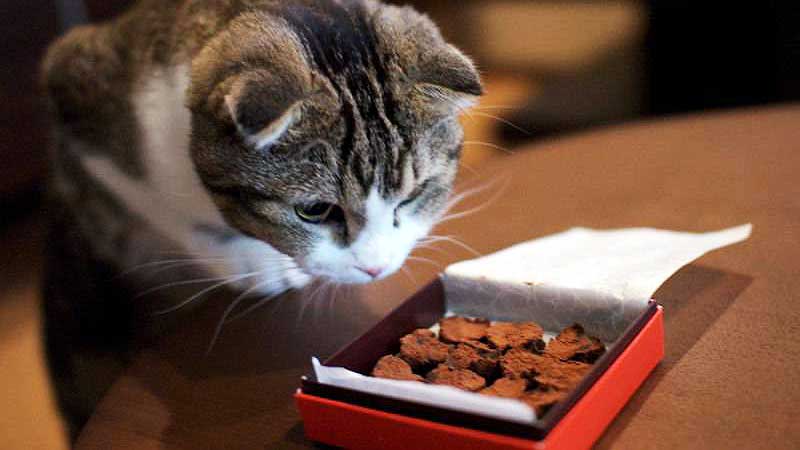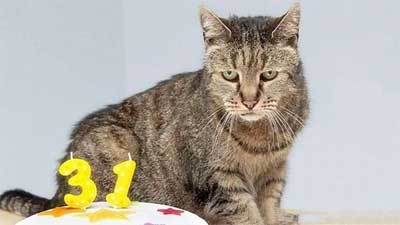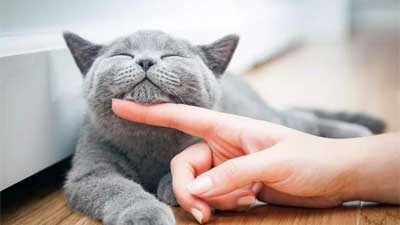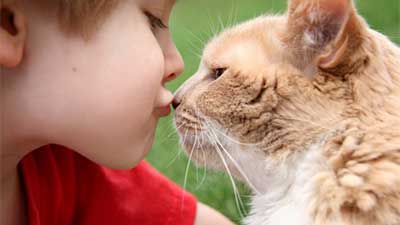Can Cats Eat Chocolate? The Answer Is An Emphatic "No!"

Cats usually stay away from chocolate. However, sometimes their curiosity can get better for them. They might end up tasting chocolate or at least try to do so.
That is when most cat owners face the question, can cats eat chocolate?
Today, we will not only answer this question but also go into the details of the answer.
Can cats eat chocolate?
Unfortunately, cats cannot eat chocolate. It does not matter whether you speak about dry cocoa powder, baking chocolate, dark, or milk chocolate. All of them are out of bounds for your cat.
If you plan to give chocolate to your cat, we strongly suggest that you do not do so.
It is now time to understand why cats can't eat chocolate.
Why can't cats eat chocolate?
Almost every ingredient in commercially sold chocolate is hazardous for your cat. Chocolate consists of sugar, fat, and xylitol. These three are incredibly harmful to your cat. However, the main risk is from the other two ingredients: theobromine and caffeine.
Theobromine is a toxin for cats and many other animals. This is why cats accidentally consume chocolate in ample quantities; it is extremely risky for them. There is almost no variant of chocolate that does not consist of theobromine. After consuming it, cats can suffer from restlessness, tremors, hyperactivity, diarrhea, and an upset stomach.
Caffeine is also very risky for cats. Caffeine results in hyperactivity, restlessness, vomiting, and so on. Also, if the amount of caffeine is high, it can lead to tremors.
These two ingredients are the main reason why cats can't eat chocolate.
Of course, as a cat owner, you would want to know what are the symptoms of chocolate poisoning in cats. That is what we will cover below.
Symptoms of chocolate poisoning in cats:
The signs and symptoms of poisoning in cats due to chocolate are:
• Diarrhea
• Faster breathing
• Accelerated heart rate
• Seizures
• Vomiting
• Restlessness
• Diarrhea
If you notice these and suspect that your cat ate chocolate, refer to the section below to understand what you should do.
What steps to undertake if your cat ate chocolate?
There are three things to do if your cat has consumed chocolate.
1. Look out for the symptoms:
It is advisable to look out for symptoms if your cat ate chocolate. You can refer to the list above to know whether the cat exhibits any of the symptoms or not.
The symptoms can occur up to 24 hours after consuming the chocolate.
A lot depends on the amount and type of chocolate consumed by the cat. The symptoms will appear much sooner if the theobromine or caffeine content is on the higher side.
2. Try to determine the type of chocolate:
Before you move to the next step, it is good to determine the type of chocolate consumed by the cat. In case you have the wrapper, keep it handy. It will have a list of ingredients, and it will be easy for the vet to understand the contents of the chocolate.
Accordingly, the treatment of the cat will progress.
Also, once you get the wrapper, it is easy to determine the quantity of chocolate that the cat might have eaten. If possible, always determine the type and quantity of chocolate the cat has eaten before following the next step.
3. Contact your vet:
Now, contact your vet immediately. He/she will ask you to bring the cat over, get the ECG done, and collect the urine sample. That will help the vet determine the severity of the reaction and accordingly administer the medicines.
You shouldn't ignore this step since only a vet can assess the chocolate's damage and provide proper treatment to your cat.
By now, you know that cats can't eat chocolate. That is why it is time to find out if there are any other alternatives that your cat can consume in place of chocolate.
Are there any alternatives to chocolate for cats?
Unfortunately, there are almost no chocolate alternators that your cat can consume. At the most, you can feed your cat special treats made for them. They, too, are sweet and can mimic the flavor of chocolate. However, if you're looking for a replacement, there is none.
We will now answer some FAQs about the consumption of chocolate by cats.
FAQs:
How much chocolate will hurt a cat?
As little as 0.2 ounces of chocolate can hurt your cat. A lot also depends on the type of chocolate. For example, 0.2 ounces of baking chocolate can result in side effects. On the other hand, when speaking about dark chocolate, the symptoms appear only if your cat has consumed 0.5 ounces of dark chocolate. However, a lot depends on the weight of your cat. The lower your cat's weight, the more will be the side effects with even a limited quantity of chocolate consumption.
Can a cat survive after eating chocolate?
Yes, the cat can survive eating chocolate if the treatment is started as soon as possible. A lot also depends on the quantity of chocolate consumed. If the cat has had a relatively higher quantity of chocolate, the symptoms will start with rapid breathing, and seizures and can also prove fatal if treatment is not administered.
How long does it take for chocolate to affect a cat?
Chocolate poisoning symptoms in cats can be visible in as little as 2 hours. In some cases, the symptoms can occur after 24 hours as well. Because of the same, you need to be alert for at least 1 day after your cat has consumed chocolate. If you notice the symptoms within 4 to 6 hours after consumption, it is good to take your cat to the vet as a preventative measure.
What if my cat ate a brownie?
Unfortunately, brownie consists of chocolate and various other components that are not suitable for consumption by a cat. You will still have to contact your vet if your cat has consumed brownie.
Conclusion:
So, the answer to the question of can a cat eat chocolate is a strict no. When you have a cat in your home, it is good to avoid keeping chocolate at your home to avoid the probability of accidental consumption.
If your cat has already consumed chocolate, you can refer to the section that lets you know what you should do. It is necessary to watch out for the symptoms in that case.
References
- [1] ^ PetMD: Can Cats Eat Chocolate?
- [2] ^ The Spruce Pets: How Much Chocolate Is Toxic to Cats?
You May Also Like
 Help & AdviceTo Keep Your Cat Live Longer, These 8 Factors Must Be Paid Attention To
Help & AdviceTo Keep Your Cat Live Longer, These 8 Factors Must Be Paid Attention To Cat GroomingTips and Tricks on How to Take Care of Your Cat
Cat GroomingTips and Tricks on How to Take Care of Your Cat Ranking Lists10 Cat Breeds That Live the Longest (Ranked)
Ranking Lists10 Cat Breeds That Live the Longest (Ranked) Cat BehaviorIf The Cat Is Well Raised, There Will Be These 6 Behaviors!
Cat BehaviorIf The Cat Is Well Raised, There Will Be These 6 Behaviors! Breed Reviews6 Advantages Of Raising A Male Cat, More Suitable For Novices
Breed Reviews6 Advantages Of Raising A Male Cat, More Suitable For Novices Cat BehaviorThe 6 Meanings of a Cat's "Nose Kiss", Do You Know?
Cat BehaviorThe 6 Meanings of a Cat's "Nose Kiss", Do You Know?